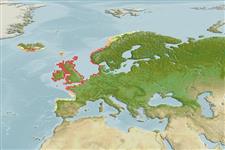Common names from other countries
Classification / Names / Names
Nomi Comuni | Sinonimi | Catalog of Fishes (gen., sp.) | ITIS | CoL | WoRMS
Environment: milieu / climate zone / depth range / distribution range
Ecologia
; salmastro; distribuzione batimetrica 7 - 9 m (Ref. 2851). Temperate
Northeast Atlantic: Europe.
Length at first maturity / Size / Peso / Age
Maturity: Lm ? range ? - ? cmEtà massima riportata: 1.00 anni (Ref. 130103)
Depth based on occurrence (Ref. 2851, p. 719); to be replaced with better reference. Life span is less than 1 yr (Ref. 130103). Found in estuarine and inshore areas in silt to very fine sand substrate. A microvore that feeds on organic detritus (Ref. 96352).
Members of the order Cumacea are gonochoric and sexually dimorphic. Spawning is characterized by nocturnal swarming behavior. Females brood the eggs in the marsupium where they molt, become mancas and leave.
Alves, F., L. Chicharo, A. Nogueira and J. Regala. 2003. (Ref. 2851)
IUCN Red List Status (Ref. 130435)
CITES status (Ref. 108899)
Not Evaluated
Not Evaluated
Human uses
| FishSource |
Strumenti
Informazioni ulteriori
Age/SizeAccrescimentoLength-weightLength-lengthMorfologiaLarveAbbondanza
Fonti Internet
Estimates based on models
Preferred temperature
(Ref.
115969): 8.9 - 12.5, mean 10.7 (based on 314 cells).
Resilienza
Alto, tempo minimo di raddoppiamento della popolazione meno di 15 mesi (tmax<1).
Price category
Unknown.
